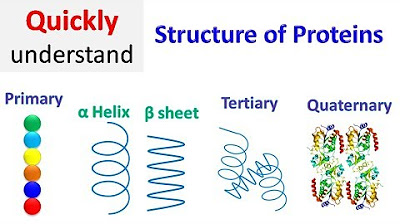Proteins Part 2
Summary
TLDRThis presentation covers the second part of protein structure, focusing on amino acid sequencing and peptide bonds. The speaker explains how amino acids form proteins, discussing the specific sequences in insulin and how peptide bonds link them. The difference between simple and conjugated proteins is highlighted, with an emphasis on the role of prosthetic groups like lipids and carbohydrates in conjugated proteins. The session also explains naming conventions for peptides and the significance of N-terminal and C-terminal ends in amino acid sequences.
Takeaways
- 🧬 The presentation discusses the structure and sequence of proteins, focusing on insulin as the first sequenced protein.
- 🔗 Insulin has two chains, and its amino acids are linked by peptide bonds in a specific order that should not be altered.
- 🧪 Each amino acid in a protein is referred to as an 'amino acid residue' when it's part of the protein structure.
- 🔍 Peptide bonds are formed between the carboxyl group of one amino acid and the amino group of another, resulting in a peptide bond.
- 📏 Proteins are read from the N-terminal (left side) to the C-terminal (right side) based on the presence of free amino and carboxyl groups.
- 📚 Amino acid sequences can be represented by their three-letter abbreviations or single-letter abbreviations for larger proteins.
- 🧩 A tripeptide consists of three amino acid residues connected by two peptide bonds.
- 🧪 The nomenclature of peptides involves using the '-yl' suffix for amino acids at the N-terminal except for the last one, which retains its full name.
- 🏗️ Proteins are classified as either simple or conjugated based on their composition: simple proteins contain only amino acids, while conjugated proteins have additional non-amino acid components called prosthetic groups.
- 💡 Examples of conjugated proteins include lipoproteins (lipid prosthetic group), glycoproteins (carbohydrate prosthetic group), and metalloproteins (metal prosthetic group).
Q & A
What is the primary structure of insulin?
-The primary structure of insulin consists of two chains of amino acids. Each chain has a specific sequence, such as glycine, isoleucine, valine, glutamic acid, and asparagine on one chain, while the other chain includes phenylalanine, valine, and alanine. This sequence is crucial and should not be altered.
What is a peptide bond, and how is it formed?
-A peptide bond is a type of covalent bond that links amino acids together in a protein. It is formed when the carboxyl group of one amino acid reacts with the amino group of another, releasing water and creating the bond between the nitrogen and carbon atoms.
What is the difference between an amino acid and an amino acid residue?
-An amino acid refers to the molecule in its free form, while an amino acid residue refers to an amino acid that is part of a protein chain.
How is a protein sequence read and organized?
-Protein sequences are read from left to right, starting with the N-terminal (free amino group) on the left and ending with the C-terminal (free carboxyl group) on the right.
What is the difference between a peptide, oligopeptide, and polypeptide?
-A peptide consists of a few amino acids linked together. An oligopeptide refers to a short chain of amino acids, and a polypeptide refers to a larger chain. A protein typically consists of one or more long polypeptides.
What is a tripeptide, and how many peptide bonds does it contain?
-A tripeptide is a molecule composed of three amino acid residues. It contains two peptide bonds linking the three residues together.
What are the naming conventions for peptides?
-Peptides are named starting from the N-terminal. The suffix '-yl' is added to the name of the amino acid, except for the amino acid at the C-terminal, which keeps its full name. For example, a tripeptide of alanine, leucine, and glycine is named alanil-leucil-glycine.
What is the difference between simple proteins and conjugated proteins?
-Simple proteins consist only of amino acid residues and no other components. Conjugated proteins contain one or more non-amino acid entities, called prosthetic groups, which can be organic or inorganic molecules, such as lipids, carbohydrates, or metals.
What are prosthetic groups in proteins?
-Prosthetic groups are non-amino acid entities found in conjugated proteins. They can include lipids, carbohydrates, or metals and are essential for the protein's function.
Why is the amino acid sequence crucial in proteins like insulin?
-The sequence of amino acids in a protein like insulin determines its structure and function. If the sequence is altered, it could disrupt the protein's ability to function correctly.
Outlines

This section is available to paid users only. Please upgrade to access this part.
Upgrade NowMindmap

This section is available to paid users only. Please upgrade to access this part.
Upgrade NowKeywords

This section is available to paid users only. Please upgrade to access this part.
Upgrade NowHighlights

This section is available to paid users only. Please upgrade to access this part.
Upgrade NowTranscripts

This section is available to paid users only. Please upgrade to access this part.
Upgrade Now5.0 / 5 (0 votes)





